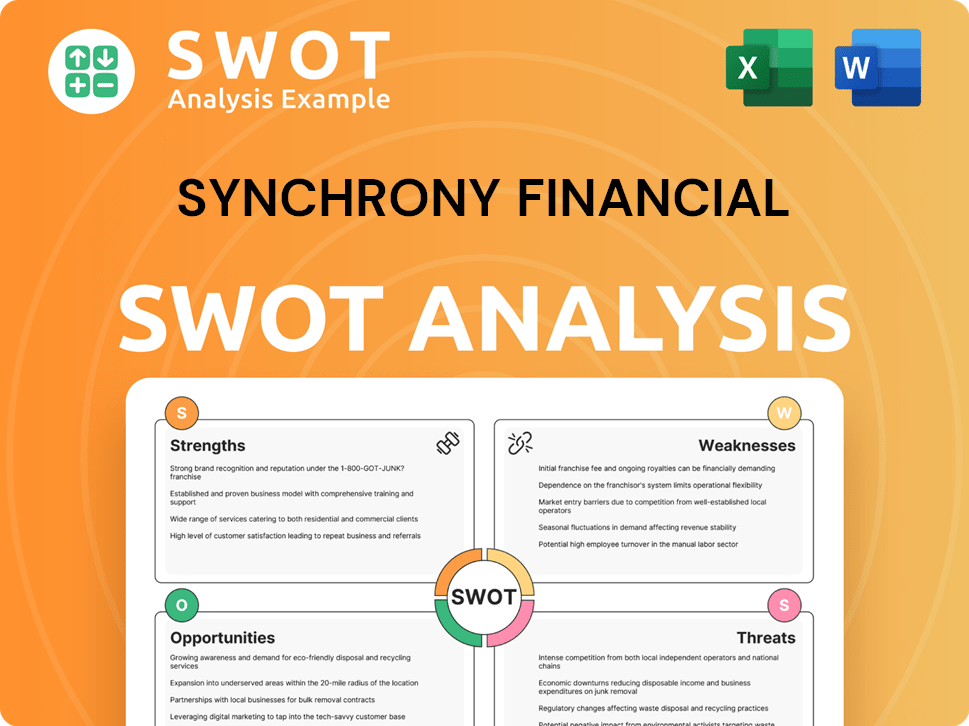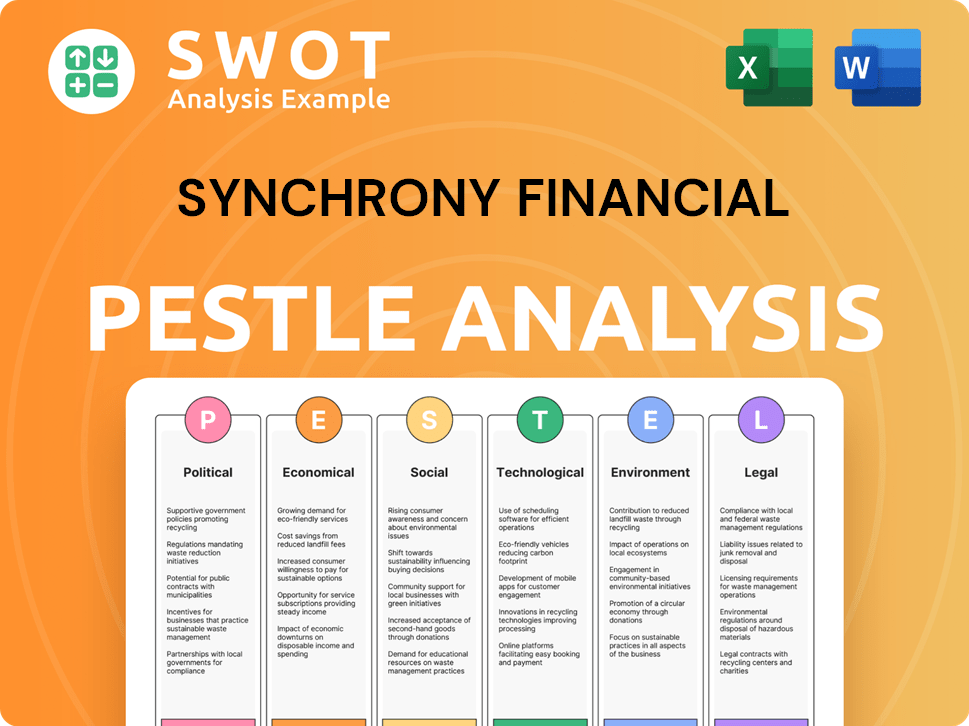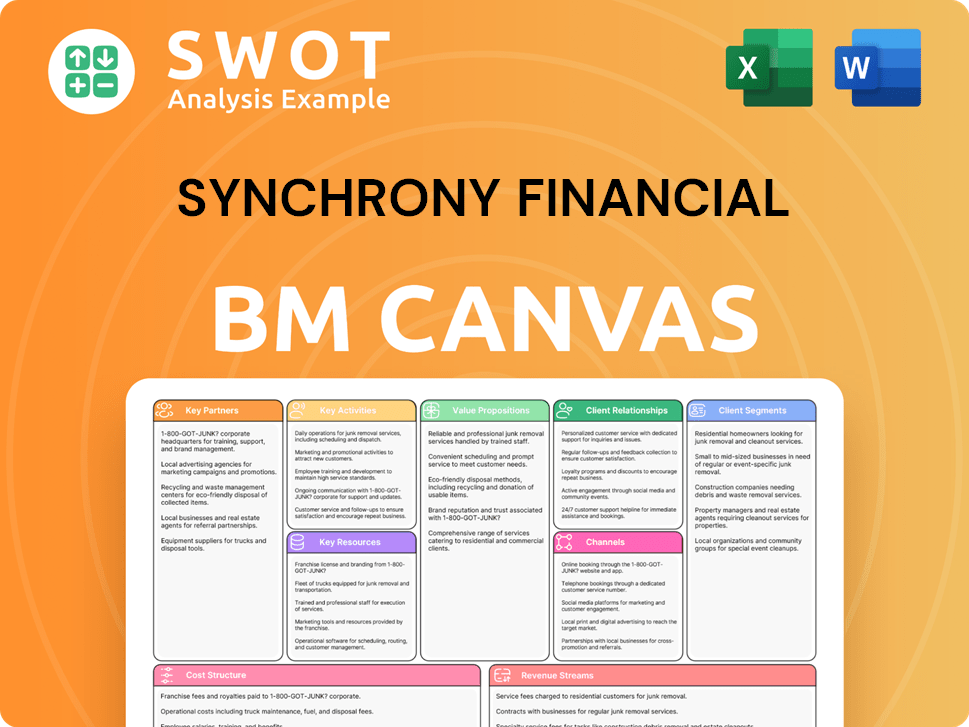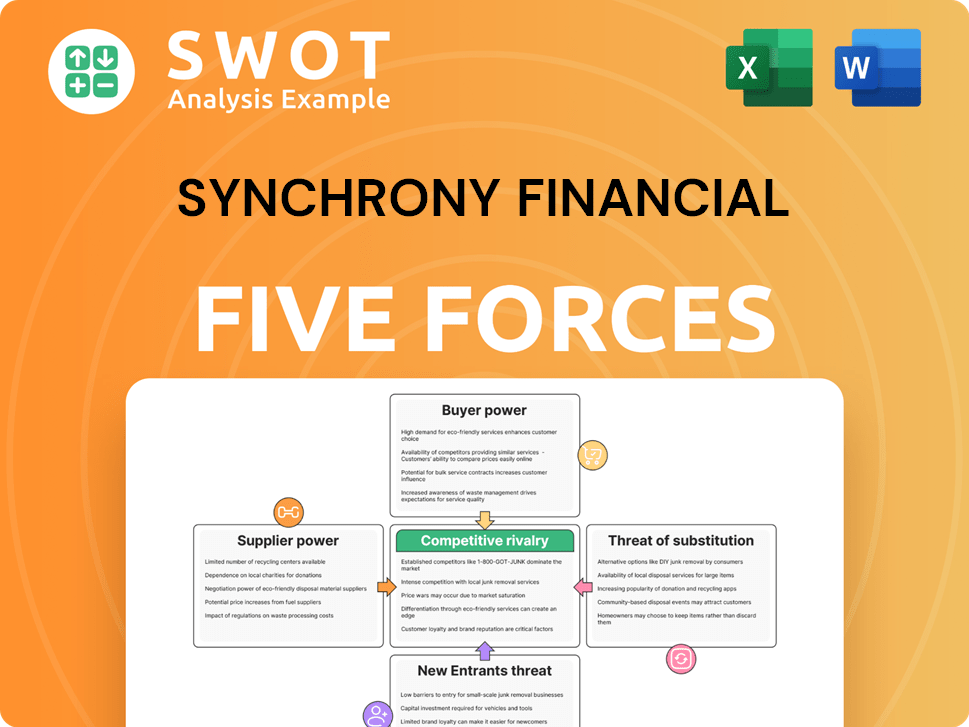Synchrony Financial Bundle
How Does Synchrony Financial Stack Up in the Financial Services Arena?
In the fast-paced world of consumer finance, understanding the Synchrony Financial SWOT Analysis is crucial. Synchrony Financial, a major player in private label and co-branded credit cards, partners with retailers and healthcare providers to offer tailored financing. This unique business model warrants a deep dive into its competitive landscape.

This company analysis will explore Synchrony Financial's competitive landscape, examining its market share and industry rivals. From its roots as part of GE to its current standing, we'll dissect Synchrony Financial's business model and financial performance. We'll also uncover its competitive advantages and potential competitive threats to understand its position in the financial services sector.
Where Does Synchrony Financial’ Stand in the Current Market?
Synchrony Financial holds a significant market position within the U.S. consumer finance sector. The company is a major player in private label credit cards, a specialized area where it competes with other large financial institutions. Its primary focus is on providing financing solutions through private label and co-branded credit cards, along with installment loans, to facilitate consumer purchases at partner locations.
The company';s operations are primarily based in the United States, serving a diverse customer base through an extensive network of partners in retail, healthcare, and automotive sectors. Synchrony has strategically expanded its offerings beyond traditional retail, diversifying into healthcare and automotive financing. This expansion helps to tap into new growth opportunities and reduce reliance on any single retail sector.
Synchrony';s financial health remains robust, as indicated by its Q1 2024 earnings. The company';s strong net interest income and healthy loan portfolio demonstrate its scale and stability within the financial services industry. This performance is crucial for understanding the Growth Strategy of Synchrony Financial and its competitive advantages.
Synchrony Financial is consistently recognized as one of the largest providers of private label credit cards in the U.S. market. While exact market share figures fluctuate, the company often competes with Capital One and Citibank in this segment. This strong position reflects its success in forming partnerships with major retailers and other businesses.
Synchrony';s geographic presence is predominantly within the United States. It serves a diverse range of customer segments through its extensive network of retail, health and wellness, and automotive partners. This broad reach allows the company to capture a significant portion of consumer spending across various sectors.
Synchrony';s primary product lines include private label credit cards, co-branded credit cards, and installment loans. These financial products are designed to facilitate consumer purchases at partner locations. The company';s focus on these core offerings is a key aspect of its business model.
Synchrony';s financial health is robust, with strong net interest income and a healthy loan portfolio. This financial stability is crucial for maintaining its competitive position. The company';s performance in Q1 2024 reflects its scale and stability compared to industry averages.
Synchrony';s competitive advantages include its strong partnerships, diversified portfolio, and financial stability. The company';s deep understanding of specific customer behaviors and partner needs in sectors like home improvement and jewelry further strengthens its market position.
- Strong partnerships with major retailers and businesses.
- Diversified portfolio across retail, healthcare, and automotive sectors.
- Financial stability demonstrated by strong net interest income and a healthy loan portfolio.
- Focus on sectors where specialized financing is crucial.
Synchrony Financial SWOT Analysis
- Complete SWOT Breakdown
- Fully Customizable
- Editable in Excel & Word
- Professional Formatting
- Investor-Ready Format

Who Are the Main Competitors Challenging Synchrony Financial?
Understanding the competitive landscape is crucial for a thorough company analysis of Synchrony Financial. The financial services sector is dynamic, with various players vying for market share. This analysis identifies key industry rivals and assesses their impact on Synchrony Financial';s position.
Synchrony Financial operates primarily in the consumer finance space, particularly in private label and co-branded credit cards. This puts it in direct competition with major financial institutions and specialized firms. Indirectly, it faces challenges from evolving payment methods and alternative financing solutions.
The competitive landscape for Synchrony Financial includes both direct and indirect competitors. Direct competitors focus on similar services, such as private label and co-branded credit cards. Indirect competitors offer alternative financial products or payment solutions that challenge the traditional credit card model.
Capital One is a major diversified financial services company. It offers a wide range of credit products and competes with Synchrony Financial through its partnerships with various retailers.
Citibank, a financial giant, is also a key player in co-branded credit cards. It leverages its extensive banking infrastructure and brand recognition to compete with Synchrony Financial.
Bread Financial specializes in private label credit programs and loyalty solutions. It directly challenges Synchrony Financial in its core business, offering integrated solutions.
Traditional banks offer general-purpose credit cards, competing indirectly with Synchrony Financial. These banks leverage their existing customer base and financial services offerings.
BNPL providers like Affirm and Klarna represent a disruptive force in the market. They appeal to younger demographics and challenge the traditional credit card model, indirectly competing with Synchrony Financial.
Fintech startups offer alternative financing solutions. These firms compete indirectly with Synchrony Financial by providing innovative financial products and services.
These competitors utilize different strategies to gain market share. Capital One and Citibank leverage their broader financial product offerings. Bread Financial focuses on integrated loyalty and marketing solutions. High-profile partnerships are often determined by revenue share, data analytics, and customer service. The rise of BNPL services poses a significant challenge, especially among younger consumers. For more detailed insights, you can refer to an article about Synchrony Financial';s business model and competitive position. here.
Several factors drive competition in the consumer finance market, influencing Synchrony Financial';s ability to maintain and grow its market share.
- Partnerships: Securing and maintaining partnerships with major retailers is crucial.
- Revenue Share: Competitive revenue-sharing agreements impact profitability.
- Data Analytics: Advanced data analytics capabilities are essential for understanding customer behavior and risk.
- Customer Service: Providing excellent customer service is vital for customer retention and satisfaction.
- Product Innovation: Offering innovative credit products and features is important to attract and retain customers.
Synchrony Financial PESTLE Analysis
- Covers All 6 PESTLE Categories
- No Research Needed – Save Hours of Work
- Built by Experts, Trusted by Consultants
- Instant Download, Ready to Use
- 100% Editable, Fully Customizable

What Gives Synchrony Financial a Competitive Edge Over Its Rivals?
Understanding the Synchrony Financial competitive landscape involves recognizing its key advantages in the financial services sector. A deep dive into company analysis reveals a business model centered on specialized credit solutions. This focus allows for strong partnerships and tailored offerings, setting it apart from traditional financial institutions. Examining Synchrony Financial';s market position 2024 shows a company that has carved out a unique space through strategic alliances and data-driven insights.
Synchrony Financial';s competitive advantages stem from its ability to integrate seamlessly with partners like retailers, healthcare providers, and automotive businesses. This approach fosters long-term relationships and provides a competitive edge. The company's focus on private label and co-branded credit programs allows for a highly customized experience, driving customer loyalty. Analyzing Synchrony Financial';s financial performance highlights the success of this strategy.
The company leverages proprietary technology and advanced data analytics to refine its offerings. This data-driven approach enhances risk management and optimizes marketing efforts, providing a competitive edge. The brand's equity within the private label credit card space, built over decades, contributes to customer loyalty. This is a crucial element when considering how does Synchrony Financial compare to its rivals.
Synchrony Financial has cultivated strong relationships with major retailers and healthcare providers. These partnerships are a cornerstone of its business model, providing a steady stream of customers. These alliances also allow for tailored credit solutions that meet specific partner needs.
The company uses advanced data analytics to develop sophisticated underwriting models and personalize credit offers. This data-driven approach enhances risk management and optimizes marketing efforts. Investments in technology are crucial for maintaining a competitive advantage in the financial services industry.
Synchrony Financial benefits from strong brand recognition within the private label credit card space. Consumers often associate the credit offering directly with the retailer they are shopping with, fostering loyalty. This brand equity is a key differentiator in a competitive market.
Synchrony Financial focuses on efficiency through its streamlined operations and technology investments. This operational focus allows the company to offer competitive rates and services. The company continuously seeks ways to improve efficiency.
Synchrony Financial';s competitive advantages include its specialized business model, deep partner relationships, and advanced data analytics. These strengths enable it to offer tailored credit solutions and build strong customer loyalty. The company's focus on innovation and operational efficiency further enhances its market position.
- Specialized business model focused on private label and co-branded credit cards.
- Strong partnerships with major retailers, healthcare providers, and automotive businesses.
- Advanced data analytics capabilities for underwriting, personalization, and risk management.
- Brand equity and customer loyalty within the private label credit card space.
- Continuous investments in technology and operational efficiency.
Synchrony Financial Business Model Canvas
- Complete 9-Block Business Model Canvas
- Effortlessly Communicate Your Business Strategy
- Investor-Ready BMC Format
- 100% Editable and Customizable
- Clear and Structured Layout

What Industry Trends Are Reshaping Synchrony Financial’s Competitive Landscape?
The consumer finance industry is undergoing a significant transformation. This shift is driven by technological advancements, evolving consumer preferences, and regulatory changes. For Synchrony Financial, understanding these trends is crucial for maintaining its competitive position. The company's success hinges on adapting to the digital landscape and managing risks effectively, as explored in a recent analysis of its Marketing Strategy of Synchrony Financial.
Synchrony Financial faces both opportunities and challenges in this dynamic environment. The rise of e-commerce and digital payments requires continuous investment in technology and risk management. Regulatory changes and economic uncertainties further complicate the landscape, demanding strategic agility and a proactive approach to market dynamics. The company's ability to navigate these complexities will determine its future performance and market share.
The industry is seeing a surge in e-commerce, requiring robust digital credit processes. Digital payment methods are becoming more prevalent, influencing consumer behavior. Buy-Now-Pay-Later (BNPL) solutions are gaining popularity, presenting both competitive threats and potential opportunities for expansion.
Regulatory changes in consumer lending and data privacy pose ongoing challenges. Economic uncertainties, such as inflation and interest rate fluctuations, can impact consumer spending and credit quality. Maintaining compliance and adapting to market volatility are critical.
Emerging markets offer specialized financing opportunities, particularly in healthcare and elective procedures. Product innovations, such as enhanced mobile payment options and personalized financial tools, can drive growth. Strategic partnerships with fintech companies can expand technological capabilities and reach.
Synchrony's competitive position is evolving towards a digitally integrated and diversified financial services provider. The company leverages its partner-centric model and data analytics to remain resilient. This strategic focus is key in a dynamic environment.
In 2024, the consumer finance market is projected to reach significant values. The adoption of digital payment methods continues to rise, with mobile payments expected to account for a substantial portion of transactions. BNPL solutions are experiencing rapid growth, capturing a notable share of consumer spending.
- The consumer finance market is projected to reach over $5 trillion in 2024.
- Mobile payments are expected to constitute over 40% of all digital transactions.
- BNPL solutions are predicted to account for more than 10% of e-commerce spending.
- Synchrony Financial's loan portfolio performance is influenced by these trends.
Synchrony Financial Porter's Five Forces Analysis
- Covers All 5 Competitive Forces in Detail
- Structured for Consultants, Students, and Founders
- 100% Editable in Microsoft Word & Excel
- Instant Digital Download – Use Immediately
- Compatible with Mac & PC – Fully Unlocked

Related Blogs
- What are Mission Vision & Core Values of Synchrony Financial Company?
- What is Growth Strategy and Future Prospects of Synchrony Financial Company?
- How Does Synchrony Financial Company Work?
- What is Sales and Marketing Strategy of Synchrony Financial Company?
- What is Brief History of Synchrony Financial Company?
- Who Owns Synchrony Financial Company?
- What is Customer Demographics and Target Market of Synchrony Financial Company?
Disclaimer
All information, articles, and product details provided on this website are for general informational and educational purposes only. We do not claim any ownership over, nor do we intend to infringe upon, any trademarks, copyrights, logos, brand names, or other intellectual property mentioned or depicted on this site. Such intellectual property remains the property of its respective owners, and any references here are made solely for identification or informational purposes, without implying any affiliation, endorsement, or partnership.
We make no representations or warranties, express or implied, regarding the accuracy, completeness, or suitability of any content or products presented. Nothing on this website should be construed as legal, tax, investment, financial, medical, or other professional advice. In addition, no part of this site—including articles or product references—constitutes a solicitation, recommendation, endorsement, advertisement, or offer to buy or sell any securities, franchises, or other financial instruments, particularly in jurisdictions where such activity would be unlawful.
All content is of a general nature and may not address the specific circumstances of any individual or entity. It is not a substitute for professional advice or services. Any actions you take based on the information provided here are strictly at your own risk. You accept full responsibility for any decisions or outcomes arising from your use of this website and agree to release us from any liability in connection with your use of, or reliance upon, the content or products found herein.